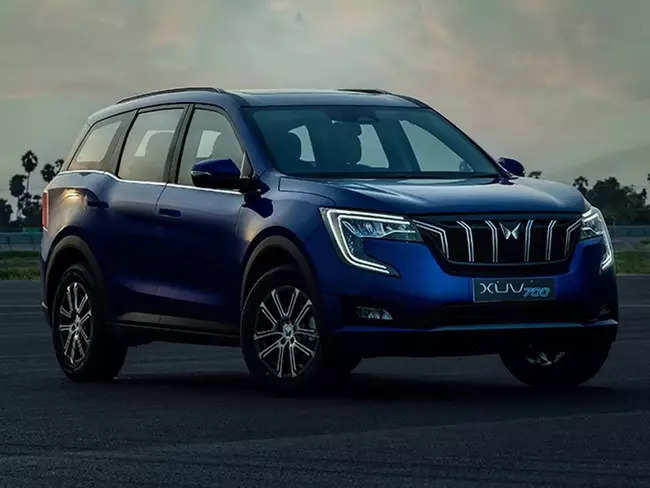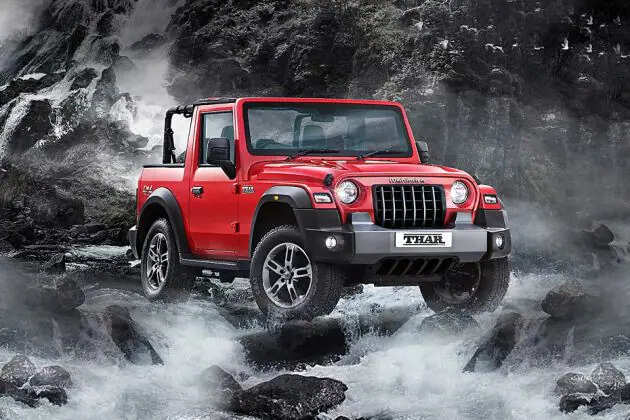
SUV maker Mahindra & Mahindra’s share of 7.2% during April – November 2021 in the Indian passenger vehicle market is close to the share it had in 2018-19, the peak year for the Indian automotive industry.
The Mahindra XUV700, bookings for which opened in October, is one of the key launches in the Indian passenger vehicle segment in 2021. It is also the first fruit of the various new practices adopted in Mahindra & Mahindra’s product planning division during the past few years.
At the bottom of it all is the core factor of planning for a new product. “We will now try and play the game to our strength. Volume opportunities won’t be the driving factor anymore,” Rajiv Mehta, head – global product planning (automotive division), M&M, told ETAuto.
In the new approach, M&M has been defining and developing its models under an umbrella of only three or four key attributes. For the XUV 700, they were design, technology, and performance. For performance, Mehta said the 200HP target for the petrol XUV 700 was decided right at the beginning, to give the XUV 500’s successor a ‘wow’ factor.
The XUV 500 had a power output of 140 HP. The proposal startled Pawan Goenka, then M&M’s MD, but he bought the idea later.
Another key change for M&M was that the entire product planning team was given the right to define a model and take the responsibility for its success or failure.
Now management has clearly entrusted planning the final call on what the mix should be to the planning team. People can come and give views, but the decision matrix is with the planningRajiv Mehta, Head, Global Product Planning (Automotive Division), M&M
Earlier, the decision matrix for defining a model straddled over multiple teams. “Now management has clearly entrusted planning the final call on what the mix should be to the planning team. People can come and give views, but the decision matrix is with the planning,” Mehta said. According to him, this new culture helps to “keep things under control”, without any deviations. “That’s a very good thing because then you are accountable and you are responsible for everything. That’s one key thing that has happened. Now, it’s up and running for the past 3-4 years,” he added.Though Mehta and team are receiving bouquets for the XUV 700’s market performance, they also get brickbats for the not-so-successful models. “Brickbats do come our way, but as long as you stay true to the story which you had in mind, that’s where you get it right. The moment you deviate, you lose out on the big picture,” Mehta said.
. Models like KUV 100 and Marazzo didn’t get M&M what it wanted. Mehta argues that “they were the right things to do at that point of time”, but also admits that KUV 100 was “perhaps a little off” from what brand Mahindra stood for. Now, Mahindra wants to be seen as a maker of only ‘authentic SUVs’.
So, a model like Marazzo, which was developed to tap the volume opportunity in a less competitive segment, may never happen again. The KUV, however, would make a return in an electric avatar. In the ICE version, the KUV didn’t make the cut. The market performance analysis showed it was a misfit for the Mahindra brand, and also wasn’t delivering what most of the customers in the segment wanted. “The whole appeal of the brand and its relevance in its life cycle was sort of not the right thing for a KUV. It’s more of a value-driven purchase (in the segment), where KUV was all about power. They didn’t want 0-100 in 10 secs, they wanted 20 kmpl,” Mehta said.
New practices for smarter product planning
Product planning is like preparing an exotic dish that has a whole lot of ingredients, and requires a long time to get cooked. Planning for the XUV 700 began in 2012, a little over a year after the XUV 500’s launch. With the automotive industry landscape getting increasingly disruptive and competitive, product planners have to be on their toes more than ever before. “The way we see planning is what we call as the nucleus of everything that happens in the company. So we have engagements with internal stakeholders and external stakeholders,” Mehta said.

It’s important that OEMs not only keep an eye on what competition is doing, but in this disruptive age where innovation is becoming the name of the game, it is also important to be abreast of technologies. And motor shows are good grounds to make oneself bring up to speed about the latest developments, and also possibly something that could help make a product stand out in the market.
Usually, component makers do not get much of the OEM teams’ attention in various shows in India and overseas. Mehta himself was also “guilty” of it, but there is a change at M&M now. “Consciously we started asking the team to also attend the ACMA Show. Even globally, we would go and see only the big OEMS,” Mehta said. That changed a few years ago. “Now, he said, for the first two days we see the component manufacturers’ stalls before we go and see who is doing what at the OE level.”
The idea is to first go and see what the misses are. For example, if an OEM is putting up some technology and the vendors are showcasing something else which no OEM has picked up yet, then that could also be an opportunity for OEMs to explore. “That also tells you that this is something of a nascent technology that is untapped. So, why can’t I be the first?” Mehta said.
One of the key mandates in M&M’s product planning department is to bring a set of category-firsts in each of its products. But it’s not easy. Mehta said, “We attempt at least 10 but it’s now very difficult because the cycle is becoming so tight. By the time you want to go first somebody has already come in.”
In addition to visiting suppliers’ pavilions in motor shows, M&M has also started hosting ‘technology days’ once a quarter in its premises, where major Tier 1s are invited to showcase their new products and technologies. Senior management executives and the sourcing team also attend this event. Mehta and team’s job gets easier if the wares also appeal to the sourcing head. “Imagine the head of sourcing getting excited by some technology. Then it becomes his need also to make it happen,” he said. Else, it could be that the selected part/s or technology could be found too expensive!
Collaboration for growth
As the automotive/mobility industry evolves, collaboration is becoming almost a necessity. “What also is important is the ecosystem in terms of engineering consultants, or suppliers in some cases, is a very important connection to see what you can bring on to your concepts,” Mehta said.
For example, M&M’s models till not so long ago weren’t very good in terms of driving dynamics. Facing the unfavourable feedback for its products, M&M decided to tap expertise available outside the organisation. “It’s important to acknowledge, recognise that there are experts available. Not everything should be attempted to be done by you. At some point of time, I should define what I am good at and where I think I need others to contribute,” he said.
In addition to Mahindra Research Valley on the outskirts of Chennai, M&M’s network of engineering centres overseas are playing key roles in specific areas of the new and upcoming products that have the responsibility to help the OEM regain lost ground in the SUV space.
Its Detroit centre gives major support in engineering higher safety into the products. “If you were to just adapt whatever is available, it’s very expensive. So, how do we make safety affordable? This also we learnt from the experts at the Detroit tech centre,” Mehta said. M&M’s target for all new products, that started with Thar, is to earn at least a 4-star rating in the Global New Car Assessment Programme (GNCAP) crash test, he added.
Challenges to be met
Even as M&M makes some headway in growth with its new products, there are new challenges in the market. Regardless of the size or price segment a model is in, consumers compare it with models in different categories. “If you are in a certain dimension, they will compare you with smaller or bigger cars. Sometimes it becomes very difficult to convince people that what you have is the right package,” Mehta said. And that challenge also led to the planning and development of the 5-seater version of the XUV 700. This is another example of the change at M&M.
If the new Thar and the XUV 700 are any indications, the redesigned product planning approaches and strategies at M&M seem to be working. However, a lot is yet to be done. While a part of Mehta’s team is already working on products that will see the light of the day in 2028 and later, another is researching what could be in M&M’s portfolio decades later. And they need not be cars, or cars that move on roads.
Also Read:

















